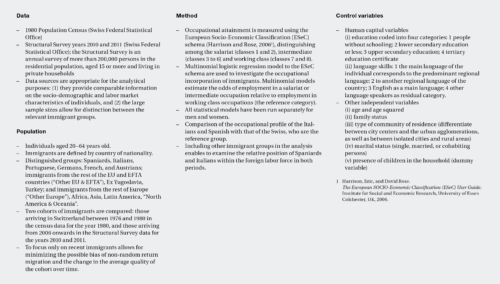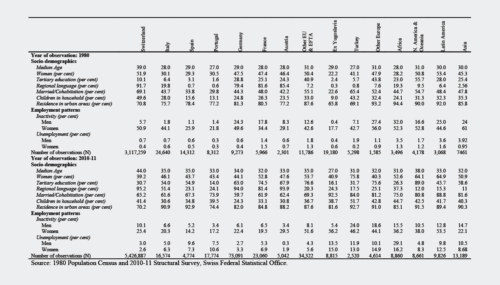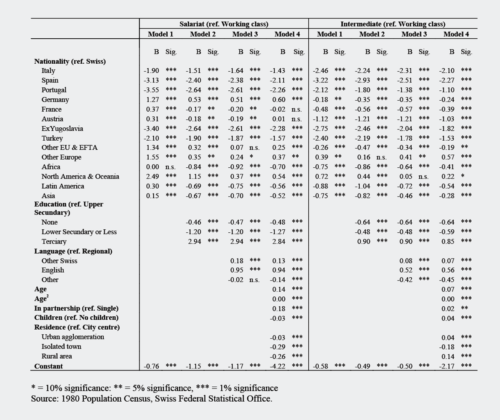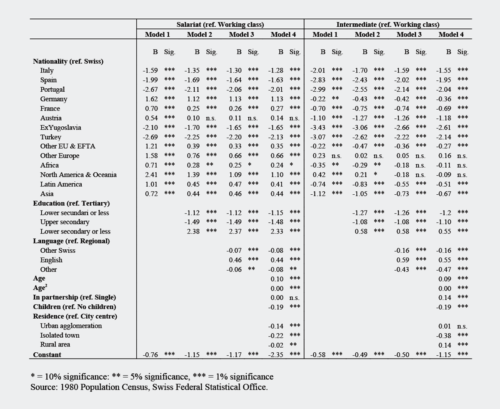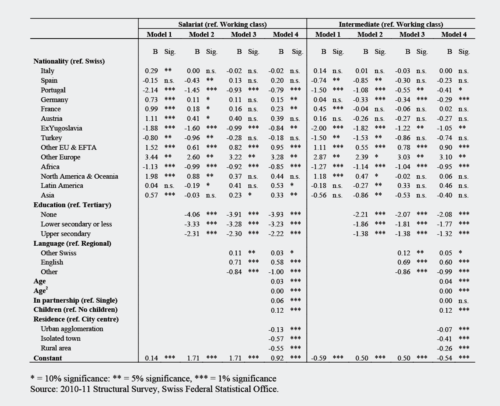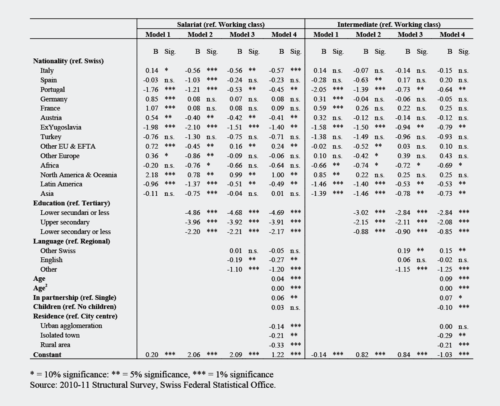highlights #1.3
How the Integration of Italians and Spaniards into the Swiss Labor Market Changed over Time

Elena Vidal Coso
Institute of Demography and Socioeconomics, University of Geneva
Enrique Ortega-Rivera
Centre for Demographic Studies, Barcelona
The uneven effects of the financial and economic crisis in Europe that started in 2007 have changed intra-European migration, giving shape to new patterns and forms of mobility of workers. The substantial decline in east-west mobility and the rise of return and circular migration have coincided with a second wave of labor migration from Southern to Northern Europe driven by countries such as Spain, Italy, Portugal, and Greece – countries, which have been severely affected by the recession and austerity.
Although the emerging pattern of south-north European mobility has attracted considerable media and policy attention, little is known about its demographic and socio-economic dimensions. This article attempts to fill this gap by providing a comparison of the socio-demographic profile and the occupational incorporation of Italian and Spanish immigrants arriving in Switzerland between 1976 and 1980 versus those arriving from 2006 onwards.
“At the end of the guest worker period, Italian and Spanish immigrants were traditionally over-represented among the lower strata of the occupational hierarchy.”
Our aim is to examine whether this is due to their negative selection in terms of human capital or because the labor market was segmented based on the worker’s origin. In addition, we investigate whether the Italians and Spaniards arriving in Switzerland in recent years are now integrated into the Swiss labor market according to their educational attainment. The comparison of two different cohorts of immigrants allows us to examine selection patterns over time and to disentangle how the changing structural and institutional characteristics of the host country have affected the labor market integration of recently arriving immigrants.
The comparison of Italians and Spaniards in Switzerland represents a relevant case study for various reasons. First, this country was one of the preferred destinations for Italian and Spanish immigrants during the guest worker period – to the point that these groups together accounted for more than half of all foreign nationals in the late 1970s. Second, these sending-countries have experienced impressive advancement in their socio-economic condition since the 1980s, with a rapid increase in the percentage of the population holding university degrees. Third, the onset of the global economic crisis in 2008 has halted career advancement prospects for many skilled professionals from these countries, which is why they increasingly searched for new labor opportunities abroad with Switzerland being a prime destination.
“As EU citizens, Italian and Spaniards currently possess a privileged legal status in Switzerland – thanks to the Free Movement of Persons Agreement and labor demand for highly skilled professionals.”
On a policy level, a better understanding of the changing profile of Southern European immigrants and their labor market situation is important – especially in a context of policy change and growing concerns about the effects of intra-European mobility on the labor markets and welfare states in the receiving countries. Although there is little hard evidence for social and wage dumping and the so-called welfare tourism, it is apparent that the increase of EU migrants has spawned some hostile attitudes among the native populations in the midst of intense public debate. Against this backdrop, some governments have recently introduced restrictive measures aimed at limiting the inflow of EU nationals to their countries. Similarly, in Switzerland – previously very open to labor migration from the EU – where the approval of the popular initiative on mass immigration in February 2014 has forced the Federal Government to implement more restrictive immigration quotas and to renegotiate the Swiss-EU Bilateral Agreement on the Free Movement of Persons. From the perspective of sending countries, although emigration could be seen as an opportunity to reduce unemployment cost, “brain drain” and the demographic impact of south-north intra-European mobility have also become highly controversial issues, as they could exacerbate the effects of the crisis and demographic imbalances in those regions.
Impressive Changes in Immigration from Italy and Spain since 1980
At the descriptive level, the comparison between immigration at the end of the guest worker period and the recent immigration from Italy and Spain reveals impressive changes.
Selected Socio-Demographic Characteristics
According to the data provided by the census of 1980, there was a marked imbalance in the sex ratio of Italian and Spanish immigrants, with women accounting for approximately 30 per cent of the total immigration. During the second half of the 2000s, however, enhanced labor market opportunities for more qualified women and family reunification resulted in a feminization of flows and, subsequently, a trend towards an equalization of the sex ratio: in 2010–11, women accounted for 46% of the Italian and 44% of the Spanish immigrants.
The cohort of Southern Europeans arriving during the second half of the 1970s was significantly younger than the cohort arriving in recent years: for both Italian and Spanish the median age increased by approximately 25 per cent, rising from 28–29 years old in 1980 to 35 years old in 2010–11. The recent cohort is more likely to be married or cohabiting and is also more likely to have children in the household, particularly among the Spanish population.
“The cohort of Southern Europeans arriving during the second half of the 1970s was significantly younger and less likely to be married than the cohort arriving in recent years.”
Lastly, the recent cohort of immigrants to Switzerland has made significant progress with regard to education. More than half of these Southern Europeans completed tertiary education: 54 per cent of the Italians and approximately 55 per cent of the Spaniards who recently arrived in Switzerland. However, their educational profile continues to be lower than the ones observed among other groups, particularly those coming from Western European countries and North America.
“More than half of the Italians and Spaniards recently migrating to Switzerland completed tertiary education.”
Patterns of Occupational Attainment
Our findings show gender-specific patterns of occupational attainment both for the earlier and the most recent cohorts of immigrants.
“The figures reflect the segmented nature of the Swiss labor market and the high selectivity of labor migration over time.”
The Italian and Spanish immigrants arriving during the guest worker period were overwhelmingly concentrated in the lower segments of the occupational hierarchy. It is also evident that men tended to be employed as skilled workers in lower technical occupations, whereas women were over-represented in routine occupations, particularly in cleaning and domestic services. In contrast, the proportion of immigrants, both males and females, from Western Europe and the Americas employed in salariat positions was higher than the respective proportion of the Swiss or other immigrants.
The occupational distribution of the most recent cohorts is somewhat different. A significant proportion of Italian and Spanish workers have gained access to the higher and lower salariat positions in line with their educational improvement. This is especially true in the case of Spanish women who have experienced an impressive occupational change in relation to their fellow countrymen.
“Despite this fact, the occupational positions of Southern Europeans lags behind those of Swiss nationals and immigrants from Western Europe and North America.”
Disadvantages for Italian and Spanish Employees
Based on a multinomial logistic regression models, we analyze whether any disadvantage exists for Italian and Spanish employees (but also for other national groups) in relation to Swiss nationals regarding their likelihood of having a salariat or intermediate occupation rather than being part of the working class. First, we obtained the coefficients for all groups. Then we controlled for educational level and language to test if the differences in occupational distribution observed between workers of different nationality are explained by their human capital. In successive models, we included other socio-demographic characteristics, such as age, family status, and residential location.
Occupational Attainment of Men and Women Back in 1980
The primary conclusion is that in 1980, men and women from Italy and, in particular, from Spain had among the lowest chances of being in salariat positions or of being in an intermediate position – as expected accordingly with the low skill composition of these national groups. Only immigrants from Portugal, the former Yugoslavia, and Turkey had even lower chances. In contrast, foreign workers from Germany, France, Austria, and to an even greater extent from “Other Europe”, “Other EU & EFTA”, as well as “North America & Oceania” had higher chances of holding salariat positions.
Does this disadvantage in occupational performance disappear when we control by educational level, primary language, or the remaining socio-demographic characteristics? The results in successive models show that the differences in relation to the Swiss population remain very high, almost unaltered.
“In 1980, immigrants from Italy or Spain had among the lowest chances of holding salariat or intermediate positions.”
A particularly interesting result is that the initial differences between the native population and foreign nationals who had a higher probability of holding a professional directive job substantially decreased – or even reversed – once controlled for human capital characteristics. This indicates that, at that moment in the history of Switzerland, these immigrants were selected because of their skills. Last, local workers had the highest probability of being in intermediate occupations. This is as a result of the nature of the Swiss educational system, which privileges apprenticeship for intermediate positions, consequently increasing the difficulty for foreign workers educated abroad to obtain any of these jobs.
“Our models show that there is a significant positive relationship between educational and occupational attainment.”
Moreover, the results predict better occupational positions for those who declare English or one of the Swiss languages as their main language in comparison to workers who declare a foreign language as their primary language. Insignificant changes occur when the results are controlled by other socio-demographic characteristics.
Occupational Positions 2010–2011 of Immigrants Having Arrived in Switzerland Since 2006
As can be observed in the multinomial logistic regression models, Italian and Spanish workers are not disadvantaged within the occupational scheme. Indeed, between Swiss workers and Italians or Spaniards there is a small and, in some cases, statistically not significant difference in the propensity of being in a salariat position instead of in the working class. Even more interesting, once we control by educational level, results reveal that the allocation of these nationals in professional and managerial positions is a consequence of their favorable skill composition, as they are better qualified on average than the native population.
“Between Swiss workers and Italians or Spaniards there is only a small difference in the propensity of being in a salariat position instead of in the working class.”
Nevertheless, the relative position of Italians and especially Spaniards among the other national groups indicates that they are still far from reaching the most favorable positions at the top of the structure occupied by other recently arrived workers from “Other EU & EFTA”, “Other Europe”, “North America & Oceania”, and other neighboring countries such as Germany, France, and Austria. When we control for the primary language, the more advantageous position of the latter groups is in part explained by the fact that they speak English or one of the Swiss native languages.
Immigrants coming from Portugal, the former Yugoslavia, Turkey, Latin America and the rest of the world, represent the other side of the story. Their chances of obtaining salariat positions are currently very low compared with the Swiss and with the above-mentioned groups of workers. Even more significant is the minimal influence that the human capital characteristics of these individuals appear to have on their ability to reach top occupational positions.
“Thus, the labor market in Switzerland continues to be segmented by national origin, and the foreign labor force continues to be polarized.”
Finally, immigrants from “Other EU & EFTA”, “Other Europe”, “North America & Oceania”, and other neighboring countries such as Germany, France, and Austria present slightly higher probabilities of holding intermediate positions in Switzerland. Concerning the impact of the remaining explanatory variables, the results reinforce the importance of educational level, language and residence in avoiding the working class positions. In addition, for both men and women, having children and living together as partners slightly increases the chances of a salariat position. However, marital status does not have any influence on obtaining an intermediate job.
Overcoming the Barriers of Negative Selectivity and a Segmented Labor Market in Switzerland
Our findings show a bipolarization of Swiss immigration at the end of the 1970s. Whereas some immigrant nationals were allocated to the top of the occupational scheme, others were more likely to be found at bottom positions of the occupational structure, and intermediate positions were mostly reserved for nationals. Foreign workers who, on average, were better qualified than the local labor force were more likely to access privileged labor positions than those who were not.
“The low educational levels of cohorts of foreign workers from Italy and Spain, as well as from Portugal, the former Yugoslavia, and Turkey explain their less favorable occupational outcomes in 1980.”
Due to their negative selection in terms of education and host language proficiency, “early” migrants from Italy (1) and Spain were among those foreign groups with strongest disadvantages on the labor market in 1980. Still, these foreign workers were also less able to translate their credentials into a good job than natives and other groups, which is typical for a segmented labor market based on origin.
The segmented nature of the labor market and the selective allocation of foreign labor from Southern Europe into low-status jobs explain the lower probability that Italian and Spanish migrants arriving during the second half of the 1970s would occupy middle-tier and professional jobs regardless of their educational and demographic profile. Moreover, the establishment of temporary resident permits could have led these migrants to decide not to invest in acquiring the human capital relevant to the host country or to invest in a long search for higher-status jobs as they were unlikely to remain in Switzerland long enough to enjoy a return on these investments.
The Swiss economy’s increasing need for highly qualified foreigners and the subsequent adaptation of migration policies brought a shift in the occupational profile of its foreign labor force. On average, the recent arrival of highly skilled migrants – mainly from Western Europe and North America – possess higher qualifications than the Swiss. Still, the entrance of low-skilled migrants has not stopped. Effectively, Switzerland is still facing the bipolarization of recent migration in terms of human capital, as well as a concentration of new migrants at the bottom of the occupational structure.
“However, the new cohorts of immigrants coming from Italy and Spain have joined the collective of highly skilled foreign workers who assume positions in the Swiss labor market, which correspond with their human capital.”
Progression of the socio-economic conditions at the origin as well as the evolution of labor demand and changing migration policies at the destination, both explain the improvement of the skills composition in the successive cohorts of Italians and Spaniards. These parallel processes also explain the improvement with regard to their occupational attainment in Switzerland.
This is a shortened and simplified version of an article to be published in Labour Migration in Europe. Changing Policies – Changing Organizations – Changing People. Special issue of International Migration edited by Barbara Laubenthal. In preparation 2016.
—
(1) Effectively, interaction term shows that Italians present better occupational outcomes when they reside in the Italian part of the country. Otherwise, when they do not share the host regional language (that is residing in the German or French parts), their probabilities of holding salariat or intermediate position are lower than for natives, regardless the educational level.
Further Readings
Afonso, Alexandre. “Immigration and its Impacts in Switzerland”, Mediterranean Quarterly, 15, no. 4 (2004): 147–166.
Favre, Sandro. “The Impact of Immigration on the Wage Distribution in Switzerland”, Working Paper Series 22. Zurich: University of Zurich, 2011.
Laganà, Francesco. “Blocked Mobility or Unemployment Risk? Labour Market Transitions of Natives and Immigrants in Switzerland”, International Journal of Comparative Sociology, 52, no. 4 (2011): 327–49.
Wanner, Philippe. “Intégration professionnelle des populations d’origine et de nationalité étrangères en Suisse”, Revue Européenne des Migrations Internationales, 20, no. 1 (2004): 1–11.
Wanner, Philippe, Denise Efionayi-Mäder, and Rosita Fibbi. “Switzerland.” In Statistics and Reality, Concepts and Measurements of Migration in Europe, edited by Heinz Fassmann, Ursula Reeger, and Wiebke Sievers.151–166. Amsterdam: University Press Amsterdam, 2009.


